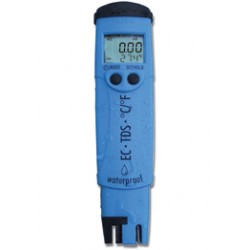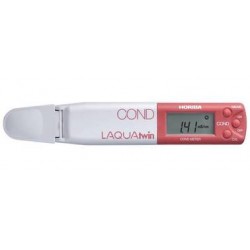No products
Conductivity Meters for Soil
Measure the EC (electrical conductivity) of soil, as well as water, compost, foliar sprays, etc.
Theoretically, ions registered by EC meters are small & mobile enough to be available to plants. Complexed ions (large array of simple ions) will not be counted by an EC meter (however, if soil contains a variety of active, healthy microbes, they...
Measure the EC (electrical conductivity) of soil, as well as water, compost, foliar sprays, etc.
Theoretically, ions registered by EC meters are small & mobile enough to be available to plants. Complexed ions (large array of simple ions) will not be counted by an EC meter (however, if soil contains a variety of active, healthy microbes, they can break down large ion clusters).
High quality water will have a low EC reading
High EC soils are very susceptible to nematodes
Viability of seed germination can be determined by EC
EC of finished compost is an indication of its quality
Notes on EC meters/probes:
All of the conductivity meters listed here have ATC (Auto Temperature Compensation), which removes errors due to changes in temperature.
All EC testers require the use of a standard solution in order to calibrate properly before performing your tests. For those meters that don’t include standards, the solutions are sold separately.
EC probes differ in their technology. For example, the 4-Ring potentiometric probe type (found on the D-4C and 9033EC models) is more accurate & reliable throughout the entire range than the 2-Ring amperometric type.
The flat sensor design of the LAQUAtwin EC meter allows it to get a reading with just a few drops of sample making it suitable for plant sap analysis.
Units of measurement:
Electrical Conductivity (EC) is measured in micro Siemens/cm (or µS/cm) or in milli Siemen/cm (mS/cm). For simplicity, we use “µS” and “mS” here. 1 mS equals 1,000 µS. (Micro Siemens was formerly referred to as micro mhos).
For conversion into “C” Salt Units: 1 “C” Salt Unit = 700 µS.
General notes:
For soil EC: Plant growth depends on the quantity of mobile ions measured in soil / water extract (this measurement is also called ERGS or energy released per gram of soil). ERGS should be kept between 40 - 400 µS.
For plant tissue EC: EC of plant sap indicates the level of simple ion uptake in plants. These are ions that are small and mobile (not yet complexed into larger molecules). Try to keep between 2,000 - 12,000 µS for optimal growth on most plants.
Conductivity Meters for Soil There are 9 products.
-
Combo 1 pH/EC Tester - HI 98129
The HI 98129 Combo waterproof tester offers high accuracy pH, EC/TDS and temperature measurements in a single tester! No more switching between meters for your routine measurements.
$220.99 -
Direct Read EC Meter - HI 98331
The HI 98331- Direct Read EC Meter is a special pocket tester designed to directly measure soil conductivity and temperature. With a temperature sensor incorporated into the penetration probe, readings are automatically temperature compensated.
$168.00 -
DiST4 Tester
DiST4 pocket tester is an affordable tester for High EC soils or for the Reams RBTI test.
$83.99 -
-
DiST6WP Tester
DiST6WP (HI 98312) EC/TDS/Temperature Tester. Pocket sized tester for high EC Soils and also for evaluating animal diets (RBTI).
$146.99 -
EC150
EC150 Electrical Conductivity/TDS/Temperature Tester. High accuracy, multi-ranging, waterproof, pocket sized tester for a wide range of applications.
$169.00 -
HI8733 EC Meter (D-4C)
Multi-range Conductivity Meter allows you to measure EC of a wide variety of substances from distilled water to fertilizer solutions.
$578.99 -
LAQUAtwin EC 11 Meter
Compact waterproof conductivity meter with flat sensor technology requiring just a couple of drops of sample.
$137.00 -
LAQUAtwin EC 22 Meter
Compact waterproof conductivity meter with flat sensor technology requiring just a couple of drops of sample.
$158.00










